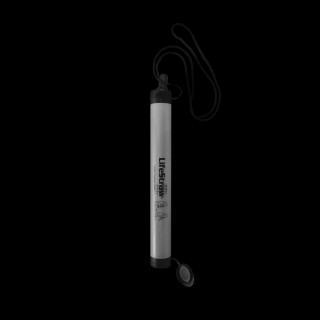- Manufacturer: Vestergaard Frandsen
- Material: polystyrene
- Dimensions: 31 × 3
- www.vestergaard-frandsen.com

Index
- Water 'All peoples have the right to have access to drinking water in quantities and of a quality equal to their basic needs.' 80% of all illness in develop
- Goals LifeStraw® water purifiers have been developed as a practical way of preventing disease and saving lives. Vestergaard company goals: Sharing a passio
- How Does It Work? How is LifeStraw® used? Simply dip LifeStraw® into a water source and suck on it to draw the purified liquid up. Who can use LifeStraw®? Since humans
- Origins The company (Vestergaard) (…) recreated an idea that Dr. Ruiz-Tiben (the director of the guinea-worm program) got from Tuareg nomads in Mali: packing
- Life Straw Distribution "The key elements in the LifeStraw's simple design are its size, its point of use methodology, and the ability to distribute it to large numbers of pe
- Critics of the Product Torben Vestergaard Frandsen self critics " Does LifeStraw® filter heavy metals like arsenic, iron and fluoride? No, the present version does not fi
- Other Solutions to Filter Water Early Water Treatment The earliest recorded attempts to find or generate pure water date back to 2000 b.c.e…Early Sanskrit writings outlined methods f
- How to Catch Water "In the desert, when mile after mile of sand and rock stretches in a shimmering sea before your eyes, the search for water can become some what tenu
- Rainwater Catchment System To build your own rain water catchment system, follow these basics steps: 1. Collect and direct it Most modern homes have a built-in gutter or downpo
'All peoples have the right to have access to drinking water in quantities and of a quality equal to their basic needs.'
80% of all illness in developing countries is caused by polluted water. It is estimated that two million people die from these illnesses every year.
Facts
- Every day, 6000 people (4000 children) die because of poor water quality
- 200 million people in the world are infected with schistosomiasis
- 6 million people are blind from trachoma
- 2.2 million deaths of diarrhoea each year mostly among children
- 10% of the population of the developing world infect by intestinal worms
Consumption
By 2025, 40% of the world population is forecasted to live in regions with catastrophically low water availability.
All around the world water consumption per inhabitant varies tremendously. For instance, an American on average uses 500 litres a day; a western European, 150 litres and an African only 50 litres a day.

LifeStraw® water purifiers have been developed as a practical way of preventing disease and saving lives.
Vestergaard company goals:
Sharing a passion to achieve the Millennium Development Goals such as poverty eradication, environmental up-gradation, gender equality, and specifically 'reducing by half the proportion of people without sustainable access to safe drinking water' by the year 2015, we recognize the immense sense of urgency.
- Offers easy access to safe drinking water away from home.
- Filters a minimum of 700 litres of water.
- Kills and removes 99.999% of waterborne bacteria.
- Kills and removes 98.2% of waterborne viruses.
- Removes particles down to 15 microns.
- Requires no electrical power or spare parts for the life time of the straw.
- Easy to mass-distribute in areas where drinking water is contaminated.
The Cochrane review (2006) demonstrates that water filters are the most effective interventions amongst all point-of-use water treatment methods for reducing diarrhoeal diseases. This study also proves that it is not enough to treat water at the point-of-source; it must also be made safe at the point of consumption.
How is LifeStraw® used?
Simply dip LifeStraw® into a water source and suck on it to draw the purified liquid up.
Who can use LifeStraw®?
Since humans have the natural ability to suck, both adults and children above three years can use LifeStraw®.
How does LifeStraw® function?
LifeStraw® contains a specially developed halogenated resin that kills bacteria and viruses on contact; a special chamber further increases the exposure of micro-organisms to the halogenated resin, thereby enhancing the killing effect. Micro-filters are used to remove all particles down to 15 microns. Activated carbon adsorbs residual iodine thereby improving the taste of water.
How do you clean it?
At regular intervals, it is recommended to do 'backwashing' that can be done by blowing out some air through the LifeStraw®. This will clean the pre-filters of whatever sand, silt and debris that might have got deposited in the textile filters.

The company (Vestergaard) (…) recreated an idea that Dr. Ruiz-Tiben (the director of the guinea-worm program) got from Tuareg nomads in Mali: packing the filter into a short plastic pipe so the user could lie down and drink from any puddle. Later versions replaced the cloth with fine metal mesh. (…)
That pipe was the inspiration for the LifeStraw, a 10-inch plastic cylinder that filters out or kills bacteria, parasites and some viruses and can be made for less than $3.
Early versions used iodine beads and a charcoal filter to lessen the iodine taste. New ones use hollow-fibre technology. (...)
"Vestergaard is just different from other companies we work with," said Kevin Starace, malaria adviser for the United Nations Foundation. "They think of the end user as a consumer rather than as a patient or a victim."
The original idea was created ten years ago by Torben Vestergaard Frandsen, but over the years in partnership with The Carter Center, Rob Fleuren from Holland and Moshe Frommer from Israel, the Lifestraw emerged from work designed to make water filters capable of safeguarding against Guinea Worm. The invention which emanated from the work, the LifeStraw, can keep away bacteria and diseases like diphtheria, cholera and diarrhoea.
The company developed the LifeStraw in conjunction with Atlanta's Carter Center, which was working on a filter that would block guinea worm, a waterborne parasite. The first prototypes were rolled out after a devastating 2005 earthquake in Kashmir that killed more than 73,000 people and left more than 3 million homeless.
"The key elements in the LifeStraw's simple design are its size, its point of use methodology, and the ability to distribute it to large numbers of people for immediate use."
Aid agencies have bought tens of thousands for use after the Myanmar cyclone and earthquakes in Asia.
The company now makes a bigger version that filters five gallons an hour with no iodine aftertaste and will last a typical family three years.
Aid agencies have bought tens of thousands for use after the Myanmar cyclone and earthquakes in Asia.
The company now makes a bigger version that filters five gallons an hour with no iodine aftertaste and will last a typical family three years.
To promote the straws, Torben has let television crews film him drinking out of Copenhagen's canals and even a toilet. "That was awful," he admitted. "It was a ladies' toilet, and they put in some odor chemical to make it smell better, and LifeStraw doesn't take out chemicals. And the canals have salt from the seawater. It can't filter that, so I drank a lot of salt."
" LifeStraw has been launched for complex emergencies like the earthquake in Pakistan where more than 70,000 LifeStraw have been distributed."
Because of economic conditions, a LifeStraw now costs $5.50, up from $4.75 a few months ago.
The design has now moved beyond prototype stages to production in China, where costs can be kept relatively low.
Torben Vestergaard Frandsen self critics
" Does LifeStraw® filter heavy metals like arsenic, iron and fluoride?
No, the present version does not filter any of the heavy metals.
Does LifeStraw® remove parasites like cryptosporidium and giardia?
No, the present version does not filter any parasites. "
" I have tried a life straw my self"
"There is no doubt that it works"
But, it is quite hard to suck the water through the filters and i doubt it will be useful for small children - unless the mothers sucks the water through first.
Second, you have to backwash the filter in order to remove "dirt". This I could imagine might give some problems for people forgetting it or not doing it correctly.
Otherwise it should work fine.
Posted by: soren falk, January 2007
External expert critics
A spokesman for UK charity WaterAid, which works to supply clean water and sanitation in 17 of the world's poorest countries, condemned the device as overly expensive, and said it was not a real solution.
The organisation's Paul Hetherington said that while he thought the LifeStraw is an 'amazing-sounding idea,' he did not ultimately think it would help.
He added that he felt the problem is that many people live very far away from their water, often walking a total of 20km or more carrying a weight of 25 kilos.
"That's what takes it out of them - the long journey," he explained.
"The LifeStraw isn't going to prevent that long journey, even if it does improve the water they drink.
'It only costs a charity like WaterAid £15 per person to provide them with water, sanitation and hygiene education, which, provided there is decent water resource management in the country, will last them a lifetime."
Early Water Treatment
The earliest recorded attempts to find or generate pure water date back to 2000 b.c.e…Early Sanskrit writings outlined methods for purifying water. These methods ranged from boiling or placing hot metal instruments in water before drinking it to filtering that water through crude sand or charcoal filters.
The first record of experimentation in water filtration, after the blight of the Dark Ages, came from Sir Francis Bacon in 1627. Hearing rumours that the salty water of the ocean could be purified and cleansed for drinking water purposes, he began experimenting in the desalination of seawater. (...)
The Use of Chlorine to Purify Water
Chlorine was first recognized as a valuable chemical in treating water when John Snow used it to purify the cholera-causing water of the Broad Street Pump.
Chlorination of drinking water, combined with the use of sand water filters resulted in the virtual elimination of such waterborne diseases as cholera, typhoid, and dysentery. In fact, chlorine was so effective at eliminating the outbreak and spread of waterborne diseases that Life magazine named water chlorination as "probably the most significant public health advance of the millennium"
Chlorine has now been a major part of municipal water treatment for nearly 100 years.
Whole House Water Filters
The whole house water filter unit is designed as a point-of-entry system that filters water directly as it enters a home plumbing system from a municipal or private well water source
Most whole house water filters use a four-stage filtration system. The first stage of filtration removes any sediment materials in the water that may clog the filter, reducing its effectiveness. The second stage then uses a chemical process called water atomization to alter the molecular structure of chlorine and turn it into the harmless molecule, zinc chloride. The third and fourth stages of filtration involve bituminous-activated carbon and coconut-shell activated carbon media to filter pesticides, remnants of biological matter, and other harmful chemicals. Bituminous-activated carbon is currently the best available technology for filtration purposes.

- www.historyofwaterfilters.com
- upload.wikimedia.org/wikipedia/commons/1/1a/Nuremberg_chronicles_-_Strange_People_-_Straw_Man_(XIIr).jpg
- chestofbooks.com/food/household/The-Profession-Of-Home-Making/images/Fig-5-A-Water-Filter.jpg
Natural water filtering alternatives
An open-source, do it yourself technology for solar water disinfection, SODIS uses UVA radiation and the sun's heat to eliminate pathogens that cause diarrhea and other waterborne diseases. The simple technique is ideal for small quantities of water to be used at the household level. All that is needed is a supply of transparent glass or PET plastic bottles and adequate sunlight. Bottles are filled with water and placed under the sun atop the home's roof, if possible on a corrugated iron sheet that reflects the sunlight. The bottles must be left in the sun for six hours at 50 percent cloudiness and two full days at 100 percent cloudiness. (...)

- Revolution , 100 products That Are Changing People’s Life» Emily Pilloton / Foreword by Allan Chochinov , Thames & Hudson
- www.rcsi.ie/sodis/images/about_graph.gif
- aliinperu.wordpress.com/2009/09/15/tierra-de-ninos-eco-school/

Clay filter
A grassroots alternative to higher tech filtration systems, Tony Flynn's three ingredient clay water filters take advantage of the inherent properties of locally available materials to provide clean drinking water in the simplest of manners. Flynn, a materials scientist and ceramics lecturer from the Australian National University, combined terra-cotta, coffee grounds (or other organic material) and cow dung to create personal-use water filters that remove common pathogens including E.coli. The filters provide a free, do-it-yourself alternative to the commercial options [...]. The filters can be made by anyone with access to crushed terra-cotta, organic material, and sufficient water to create a thick mixture that can be formed into a self supported pot. The shaped pots are sun dried until hard, then fired of dry cow dung and leaves for 45 minutes. [...] The filters safely remove 96.4 to 99.8 percent of all E.coli bacteria and can filter. 25 gallon (1L) of water in two hours. Several filters may be used in sequence for particularly contaminated or dirty water.

- www.designaddict.com/design_addict/blog/index.cfm/2009/7/28/Design-Revolution--100-products-that-empower-people
- farm4.static.flickr.com/3267/2661415967_40eb239238.jpg
How to do a clay filter yourself
- strawbale.pbworks.com/Hand-made+ceramic+water+filters
- «Design Revolution , 100 products That Are Changing People’s Life» Emily Pilloton / Foreword by Allan Chochinov , Thames & Hudson
Cattail for filtering arsenic
Jeremiah (Jerry) Jackson, an environmental and civil engineer, has developed an inexpensive arsenic filtration system using aquatic plants to improve the lives of millions affected by poisonous, arsenic-contaminated drinking water in more than 20 nations.
He only hopes that governments and nonprofits will spread the word and that people will adopt and construct the homemade system to reduce poisonous arsenic levels in their ground-water drinking supplies.
"In India, it chronically shortened people's life spans to 55 years, which is about 35 years less than what we have; and primarily that's attributed to the arsenic poisoning," Jackson said. (...)
The next step was to build a prototype that a family of five in India could easily and cheaply construct to treat their average water consumption of 50 litres per day"
The cattail actually thinks the arsenic is a nutrient," he concluded. "It absorbs it as if were a nutrient, a fertilizer. And I found the plants actually flourished." (...)
Jackson calculates the cattails can absorb the arsenic for as long as 50 years.
Indian government officials asked if the system could be expanded to protect rice crops from arsenic contamination. "I said what you do is simply line your canal that conveys water to the rice paddies with cattails. So the process is easily scalable [to larger scale domestic and agricultural applications]. And it's simple." He said he spoke to a representative of the Indian Institute of Technology six months ago. "And he said, they're pushing it and trying to implement it."
Brita
Brita is a German company that specializes in water filtration products. The company is the world's market leader in portable household water filtration. Brita products include water jugs, kettles and tap attachments, all of which use silver-impregnated activated carbon and ion-exchange resin disposable filters, as their primary filtering mechanism. The activated carbon used in Brita filters is produced from coconut shells. The company manufactures its pitchers from styrene methyl methacrylate copolymer.
Brita filters have a double action:- The activated carbon filter eliminates bad odor, and the taste of halogen compounds that chlorine makes when present in tap water.
- The exchange ion resin lowers the concentration of calcium carbonates, accordingly softening tap water.
Brita started in 1966 when Heinz Hankammer had the idea of optimizing normal tap water. He named the company after his daughter Brita. Its headquarters are in Taunusstein near Wiesbaden in Germany. In 1988 The Clorox Company, based in Oakland, California, acquired rights to the brand from the German company for North and South America.


Rainwater harvesting
This concept may not be overly fitting for Windsor's current financial hardship in terms of unit costs, but rainwater harvesting units could prove to be very cost-effective in the long-run.
Research has and is being done at the University of Guelph to produce a successful rainwater harvesting system. The system was designed by two engineering graduate students in collaboration with a local supplier of rainwater harvesting technology.
According to University of Guelph, the harvesting process goes like this: "Rainwater that lands on the home's fiberglass roof will be collected in roof gutters and downspouts and diverted to a filtration device before it is carried to a 6,500 litre underground cistern. The stored water will be pressurized and piped into the home to supply water to three toilets, the washing machine, and the dishwasher. The collected rainwater will also supply water to an underground irrigation system. This would account for over 50% of water consumption in a typical home."

"In the desert, when mile after mile of sand and rock stretches
in a shimmering sea before your eyes, the search for water can become
some what tenuous"
Fog Catcher
FogQuest is a Canadian non-profit organization that assists families in developing countries tap into fog and rainwater as a source for clean water. They use special nets on mountains for fog collection and even rock structures for dew collection, to provide water for homes, agriculture and forestry. The organization works in rural areas where conventional water supplies (such as wells, rivers, pipelines) are not available. (...) Many countries are arid or seasonally arid and could benefit from the sources of water that nature provides from the atmosphere.
The fog collector uses a 2 meter mesh surface which can collect up to 10 litres of water in 24 hours. It can be used at any time of day and needs to be facing the direction of the wind for maximum effect. The dew collector weighs just 400 grams but can collect up to 1.5 litres of drinking per night.


- www.ecofriend.org/entry/water-conservation-made-easy-with-the-latest-fog-and-dew-collectors/
- www.greendiary.com/entry/fog-catchers-brings-atmosphere-s-water-to-parched-regions/
- www.inhabitat.com/2008/06/26/harvest-water-from-the-air-with-fog-dew-collectors/
Dew Catcher
"One of the simplest desalination technologies that have received hardly any serious attention is the large-scale dew collection. Yet this is one of the major sources of water for plants and some animals in the coastal and inland deserts. In the desert environment the dew collection takes place because of night sky radiation cooling. However, for production of large quantities of water the night sky radiation is not sufficient. An alternative method is to pass the deep sea cold water through suitable heat exchangers for dew condensation. "
www.youtube.com/watch?v=tV5Z1kBbkn4To build your own rain water catchment system, follow these basics steps:
1. Collect and direct it
Most modern homes have a built-in gutter or downpour system, which makes the integration of a rainwater catchment system fairly easy. The simplest way to channel rainwater into a storage tank is to cut or redirect a downspout or use a diverting device specifically designed for the purpose, such as the Garden Water saver. If you are using a downspout, simply place the storage tank directly beneath it, leaving a little room between the opening and the tank.
2. Filter it
The rainwater has just travelled through the gutter system, so it likely has collected bugs, leaves, or other debris. Before the rainwater is stored in this tank, a basic filtration system should be emplaced to remove such matter. This can range from a simple screen placed at the end of the downspout to a fine-mesh screen that covers the mouth of the storage container.
3. Store it
Many types of storage vessels can be used, from empty wine barrels to sanitized oil drums and specifically designed plastic rain barrels […]



































































































